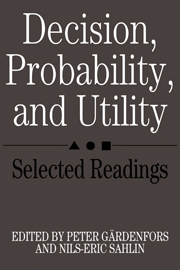Book contents
- Frontmatter
- Contents
- List of contributors
- Preface
- 1 Introduction: Bayesian decision theory – foundations and problems
- Part I Foundations of Bayesian decision theory
- 2 Truth and probability
- 3 Individual decision making under uncertainty
- 4 The sure-thing principle
- 5 Probable knowledge
- Part II Conceptualization of probability and utility
- Part III Questionable rules of rationality
- Part IV Unreliable probabilities
- Part V Causal decision theory
- References
- Name index
- Subject index
3 - Individual decision making under uncertainty
Published online by Cambridge University Press: 05 June 2012
- Frontmatter
- Contents
- List of contributors
- Preface
- 1 Introduction: Bayesian decision theory – foundations and problems
- Part I Foundations of Bayesian decision theory
- 2 Truth and probability
- 3 Individual decision making under uncertainty
- 4 The sure-thing principle
- 5 Probable knowledge
- Part II Conceptualization of probability and utility
- Part III Questionable rules of rationality
- Part IV Unreliable probabilities
- Part V Causal decision theory
- References
- Name index
- Subject index
Summary
Introduction and statement of problem
Possibly the best way to begin this chapter is to reread section 2. [cross-references to Luce and Raiffa, 1957], where we discussed the classification of decision making according to whether it is by a group or an individual and according to whether it is being carried out under conditions of certainty, risk, or uncertainty. For the ten intervening chapters we have been concerned with individual decision making in a very particular context of uncertainty known as a game. In a game the uncertainty is due entirely to the unknown decisions of the other players, and, in the model, the degree of uncertainty is reduced through the assumption that each player knows the desires of the other players and the assumption that they will each take whatever actions appear to gain their ends. Traditionally, the game model is not called decision making under uncertainty; that title is reserved for another special class of problems which lie in the domain of uncertainty. These problems, which we shall discuss presently, have for the most part grown up and been examined in the statistical literature, for they are very much involved in an understanding of experimental evidence and in drawing appropriate inferences from data.
The gist of the problem is simple to state. A choice must be made from among a set of acts A1, A2, …, Am, but the relative desirability of each act depends upon which “state of nature” prevails, either s1, s2, …, sn. The term “state of nature” will be more fully explicated later, but we hope the idea is intuitively clear.
- Type
- Chapter
- Information
- Decision, Probability and UtilitySelected Readings, pp. 48 - 79Publisher: Cambridge University PressPrint publication year: 1988
- 2
- Cited by



